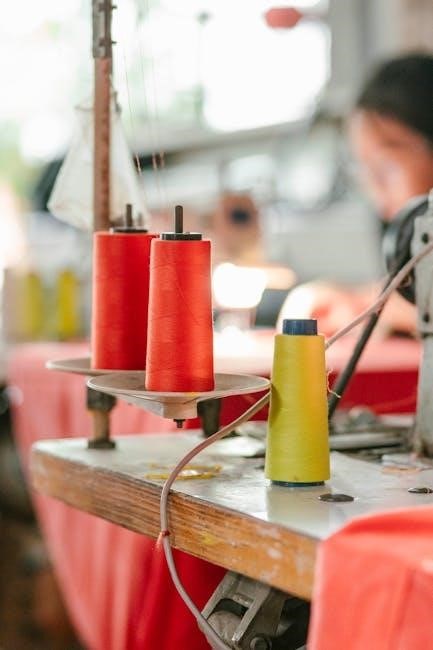Free Sewing Machine Cover Pattern PDF: A Comprehensive Guide
Discover a wide variety of free sewing machine cover patterns in PDF format‚ offering step-by-step guides for reversible‚ quilted‚ and serger covers. Perfect for all skill levels.
A sewing machine cover is a practical and stylish way to protect your machine from dust and debris while adding a decorative touch to your sewing space. Whether you’re a beginner or an experienced sewer‚ a custom cover offers both functionality and personalization. It’s an easy project that allows you to use leftover fabric or showcase your favorite prints. Sewing machine covers are versatile‚ as they can be designed to fit different machine sizes and styles‚ from compact models to large industrial ones.
With a wide variety of free PDF patterns available online‚ creating a sewing machine cover is more accessible than ever. These patterns often include step-by-step instructions‚ making it easy for sewists of all skill levels to craft a professional-looking cover. Protecting your machine has never been so fun and creative!
Why Use a Sewing Machine Cover?
A sewing machine cover is an essential accessory for protecting your machine from dust‚ debris‚ and potential damage. Dust can accumulate inside the machine‚ leading to mechanical issues over time. A cover acts as a protective barrier‚ ensuring your machine remains clean and functional. It also helps maintain the machine’s appearance and extends its lifespan. Additionally‚ a sewing machine cover can add a decorative touch to your sewing space‚ allowing you to personalize your workspace with fabric choices that match your style. Whether you’re a casual sewer or a dedicated crafter‚ a cover is a practical and easy way to keep your machine in great condition while adding a touch of creativity to your room.
Benefits of a Custom-Made Sewing Machine Cover
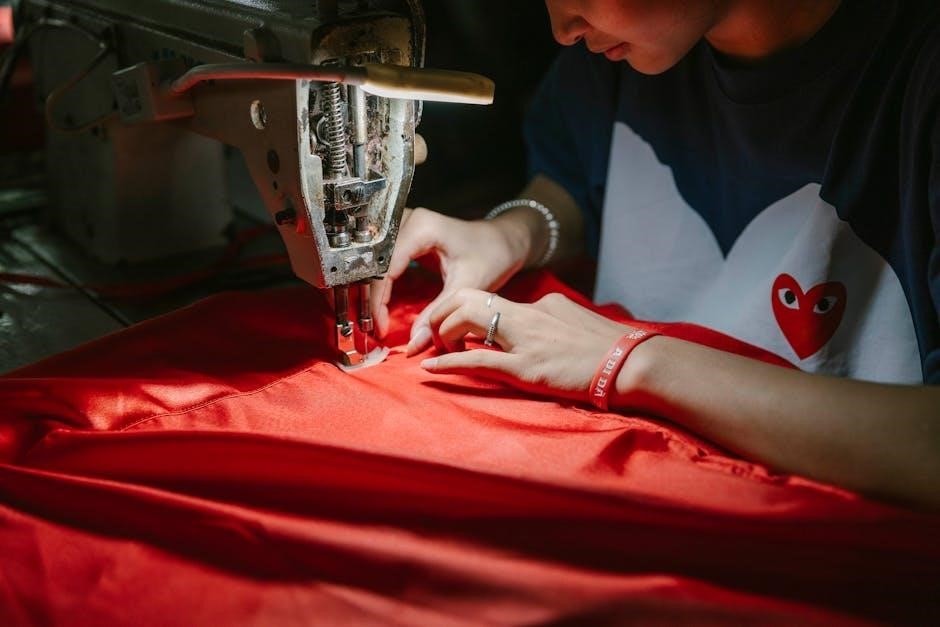
A custom-made sewing machine cover offers numerous benefits‚ starting with a perfect fit tailored to your machine’s specific dimensions. This ensures optimal protection from dust‚ moisture‚ and other environmental factors that could damage your equipment. By choosing your own fabric‚ you can personalize the cover to match your sewing room decor or favorite colors. Custom covers also allow you to add functional features like pockets for storing small accessories or decorative elements for a unique touch. Additionally‚ a well-made cover is durable and long-lasting‚ providing years of reliable service. With a custom cover‚ you can protect your investment while adding a personal and stylish flair to your workspace.
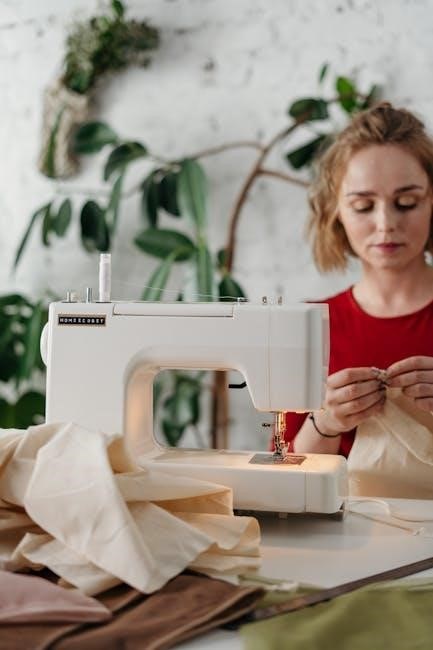
Types of Sewing Machine Cover Patterns
Explore various sewing machine cover patterns‚ including reversible‚ quilted‚ and serger designs. These styles offer dust protection‚ stylish aesthetics‚ and functionality‚ catering to different sewing needs.
Reversible Sewing Machine Cover Pattern
A reversible sewing machine cover is a versatile and stylish option‚ allowing you to switch the appearance of your cover effortlessly. Made with durable cotton fabric‚ this pattern ensures your machine stays dust-free while adding a decorative touch to your sewing space. The reversible design offers two distinct looks‚ perfect for matching different room aesthetics or seasonal themes. To create this cover‚ you’ll need two coordinating fabrics and binding for a polished finish. This pattern is ideal for sewists of all skill levels‚ offering a quick and practical project. It’s a great way to personalize your sewing machine while keeping it protected from dust and debris.
Quilted Sewing Machine Cover Pattern
A quilted sewing machine cover is a charming and practical way to protect your machine while adding a touch of handmade elegance to your sewing space. This pattern typically involves layering fabric with batting to create a padded‚ quilted design. It’s an excellent project for those who enjoy working with fabric and want a durable cover. Many free PDF patterns offer step-by-step instructions‚ making it accessible for sewists of all skill levels. The quilted design not only adds visual interest but also provides extra protection against dust and scratches. Choose from various fabric combinations to match your sewing room decor‚ ensuring a personalized and functional cover for your machine.
Serging Machine Cover Pattern
A serging machine cover pattern is specifically designed to fit the unique shape and size of sergers‚ offering protection from dust and debris. Many free PDF patterns are available online‚ catering to both beginners and experienced sewists. These patterns often include step-by-step instructions and measurements to ensure a perfect fit. The covers can be made using durable fabrics like denim or cotton‚ providing both functionality and style. Some patterns also offer customization options‚ such as adding pockets or decorative stitching. A serging machine cover is a practical project that not only protects your machine but also adds a personal touch to your sewing space. Its compact design makes it easy to sew and ensures your serger stays clean and ready for use.
Sewing Machine Dust Cover with Pocket
A sewing machine dust cover with a pocket is a practical and stylish way to protect your machine while keeping small sewing accessories organized. This design features a convenient pocket on the front‚ perfect for storing bobbins‚ needles‚ or threads. Many free PDF patterns include this feature‚ offering a step-by-step guide to create a custom-fit cover. The pocket adds functionality without compromising the cover’s simplicity. Durable fabrics like cotton or linen are ideal for this project‚ ensuring longevity and ease of cleaning. The addition of a pocket makes this cover both functional and visually appealing‚ making it a great addition to any sewing room. It’s a quick and easy project that combines protection with organization.
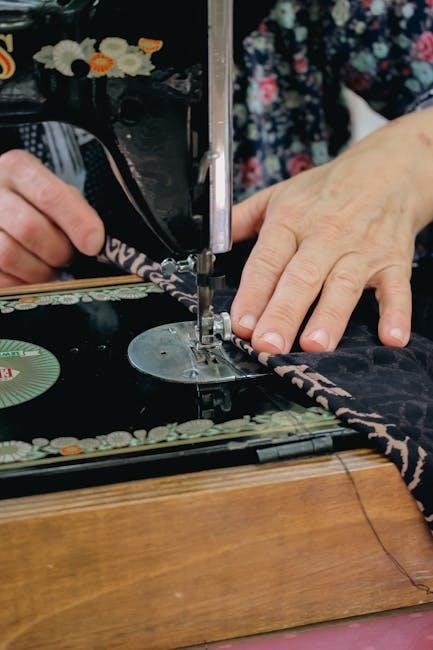
Materials and Tools Needed
Gather essential materials like durable fabric‚ stabilizers‚ and binding for a polished look. Basic sewing tools‚ such as scissors‚ pins‚ and a sewing machine‚ are also required.
Fabric Requirements for Sewing Machine Covers
Choose durable fabrics like cotton‚ denim‚ or linen for your sewing machine cover. For a standard cover‚ you’ll need 1 yard of exterior fabric and 1 yard for lining. Add 1/2 yard for binding to ensure a professional finish. If your machine is larger‚ adjust fabric quantities accordingly. Pre-wash fabrics to prevent shrinkage and ensure a perfect fit. Consider using contrasting fabrics for a reversible design or quilted patterns for added texture. These materials will protect your machine from dust while adding a personalized touch to your sewing space. Always check pattern specifications for exact measurements and fabric recommendations.
Binding and Stabilizers for a Professional Finish
Adding binding and stabilizers elevates your sewing machine cover to a professional level. Use cotton fabric for binding‚ ensuring it matches or complements your cover’s design. Stabilizers like interfacing or flexible foam provide structure and durability. Apply interfacing to fabric for stability‚ especially for pockets or quilted details. For a crisp finish‚ sew binding around edges‚ folding it inward to hide raw edges. Choose contrasting or coordinating fabrics for binding to add a decorative touch. Properly securing stabilizers ensures the cover fits snugly and protects your machine effectively. These details make the difference between a homemade and professionally crafted cover‚ ensuring long-lasting protection and a polished appearance.
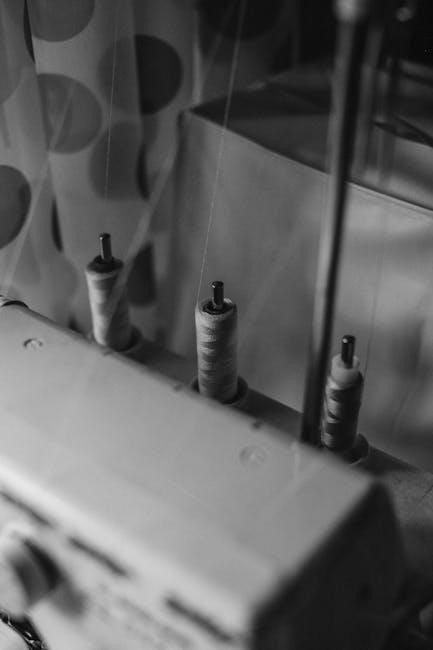
Essential Sewing Tools for the Project
To create a sewing machine cover‚ you’ll need basic sewing tools. Start with a reliable sewing machine‚ preferably one with adjustable stitch length and width. Sharp scissors or a rotary cutter and mat are essential for precise fabric cutting. Measuring tools like a tape measure or ruler ensure accurate cuts. Pins will help align fabric pieces securely. Iron and ironing board are vital for pressing seams and achieving a professional finish. A seam ripper is handy for correcting mistakes. Optional tools include a serger for finishing seams and a walking foot for smooth fabric handling. Gather these tools to efficiently complete your sewing machine cover project.
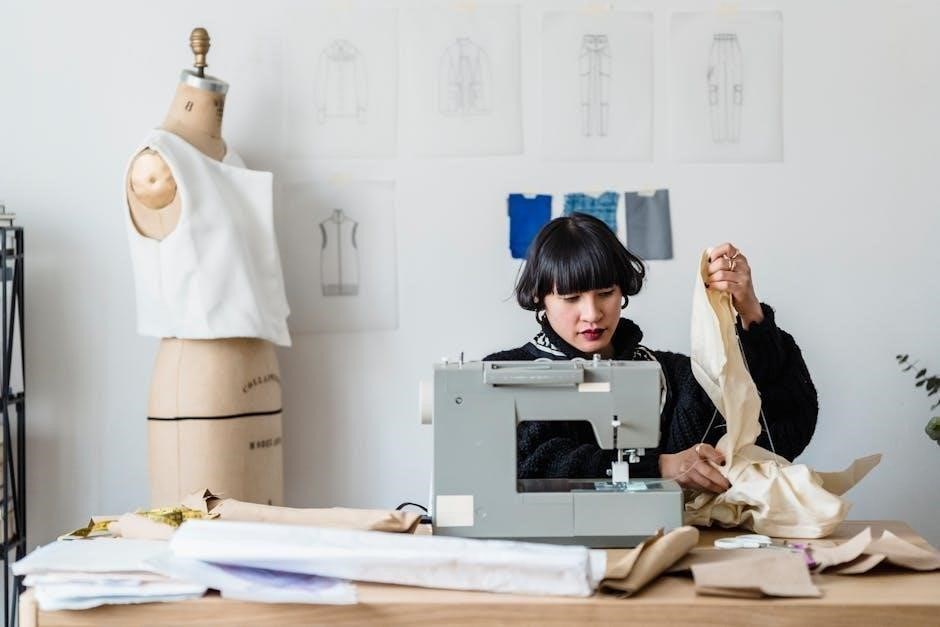
Step-by-Step Guide to Making a Sewing Machine Cover
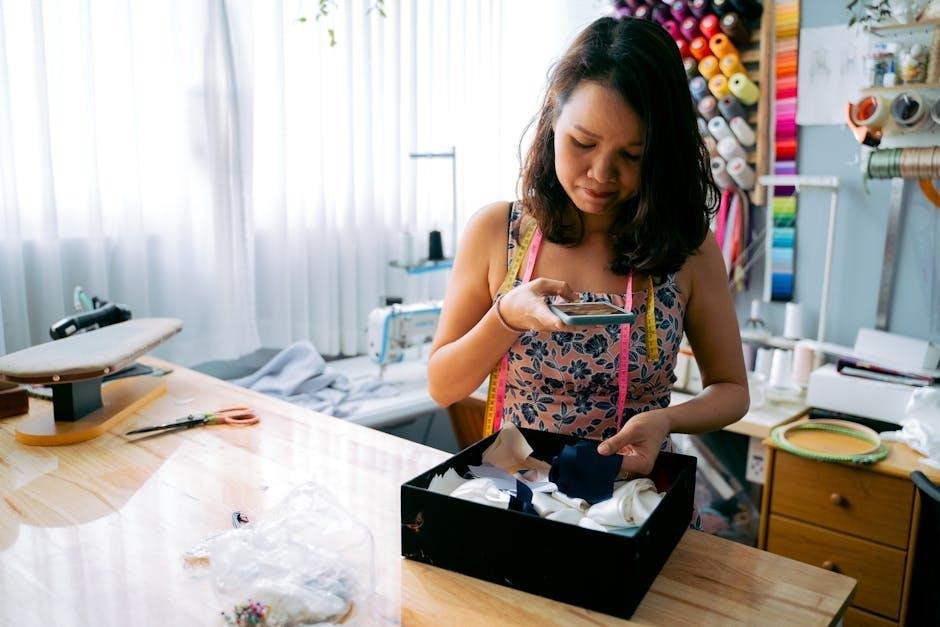
Measure your machine‚ cut fabric‚ sew pieces‚ and finish with binding. Use cotton fabric and stabilizer for durability. Follow the guide for a perfect‚ stylish cover.
Measuring Your Sewing Machine
Accurately measuring your sewing machine is the first step to creating a well-fitting cover. Start by measuring the length‚ width‚ and height of your machine. Use a flexible measuring tape to get precise dimensions‚ ensuring you account for any protrusions like knobs or levers. Note the shape of your machine‚ as some may have curved or angular features. Compare your measurements with the pattern requirements to ensure a proper fit. If your machine has unique dimensions‚ consider adding a little extra to the pattern for ease. Always double-check your measurements to avoid errors. This step ensures your cover will be tailored perfectly‚ providing optimal protection and a sleek appearance.
Cutting Fabric According to the Pattern
Cutting fabric accurately is crucial for a professional-looking sewing machine cover. Begin by laying your fabric flat on a large cutting mat‚ ensuring it is smooth and wrinkle-free. Use scissors or a rotary cutter and mat for precise cuts. Align the pattern pieces with the fabric‚ making sure to follow the grain lines indicated on the pattern. Cut slowly and carefully‚ especially around curved edges. If your pattern includes multiple pieces‚ label each one to keep track. For reversible covers‚ cut two sets of fabric. Double-check your cuts against the pattern to ensure accuracy. This step sets the foundation for a perfectly sewn cover.
Sewing the Pieces Together
Sewing the pieces together requires precision and patience. Start by pinning the fabric pieces together‚ aligning the edges carefully. Use a 1/4-inch seam allowance unless specified otherwise in your pattern. Begin with the main panels‚ sewing them together one at a time. Press the seams flat with an iron to ensure a crisp finish. If your cover has a pocket or decorative elements‚ attach them before sewing the final pieces together. Leave a small opening to turn the cover right side out. Once turned‚ press the seams again and topstitch for a professional look. For reversible covers‚ ensure the lining is securely sewn in place. This step brings your design to life‚ ready for the final touches.
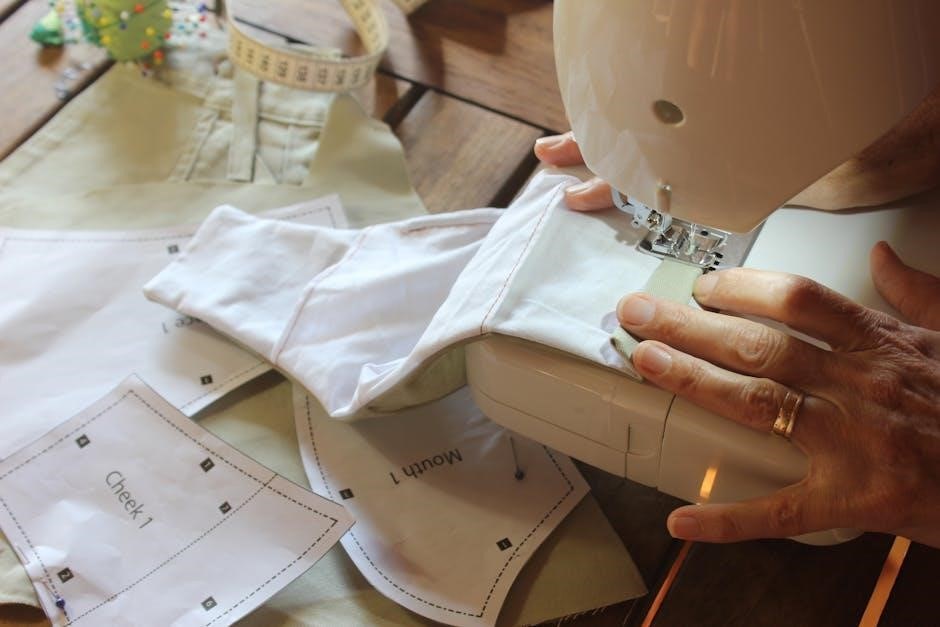
Adding Binding and Finishing Touches
Adding binding and finishing touches is the final step to complete your sewing machine cover. Start by preparing your binding strips‚ typically made from cotton fabric‚ and fold them in half lengthwise. Sew the binding to the edges of the cover‚ aligning the raw edges and folding at the corners for a neat fit. After sewing‚ fold the binding over to the inside and press it firmly. Topstitch along the binding for a professional appearance. Ensure all seams are secure and any openings are hand-stitched closed. For a polished look‚ add decorative stitches or embellishments if desired. Finally‚ press the entire cover to ensure crisp folds and a smooth finish. This step completes your custom-made sewing machine cover‚ ready to protect and enhance your machine.
Free Sewing Machine Cover Patterns Available Online
Explore a variety of free sewing machine cover patterns available online‚ offering designs in multiple sizes with step-by-step tutorials for easy customization and professional results.
Popular Websites Offering Free Patterns
Several websites provide an extensive collection of free sewing machine cover patterns in PDF format. SewCanShe‚ FaveCrafts‚ and WeAllSew are top destinations‚ offering a wide range of designs. These platforms feature patterns for reversible covers‚ quilted designs‚ and serger covers‚ catering to all skill levels. Many patterns include step-by-step tutorials and customizable options. Craftsy and Pinterest also offer inspiring ideas and downloadable guides. These resources are perfect for sewists looking to protect their machines while adding a personal touch to their sewing spaces. With so many options available‚ finding the ideal pattern to suit your style and machine size is effortless.
How to Download and Use PDF Patterns
Downloading and using free sewing machine cover PDF patterns is straightforward. Start by visiting reputable websites like SewCanShe or FaveCrafts‚ where you can find a variety of designs. Once you locate a pattern‚ click the download link to save the PDF to your device. Open the file using a PDF reader and print it at 100% scale to ensure accuracy. Cut out the pattern pieces carefully and use them as templates to cut your fabric. Follow the included instructions for sewing the pieces together. Many patterns offer step-by-step guides‚ making the process easy for beginners. For durability‚ consider laminating the pattern before use.
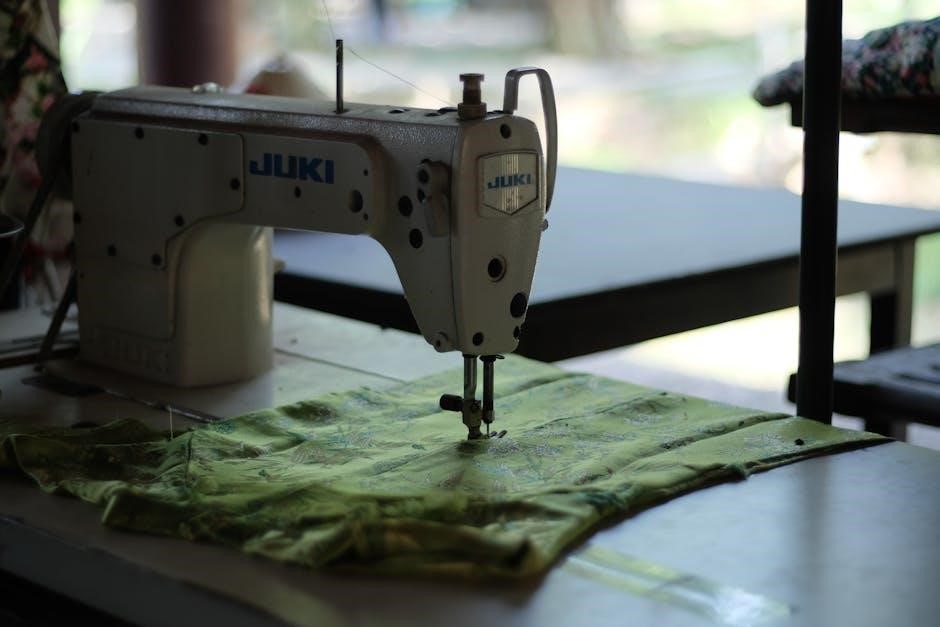
Customizing Your Sewing Machine Cover
Personalize your sewing machine cover with vibrant fabrics‚ decorative stitches‚ and reversible designs. Choose materials like denim or cotton for a unique‚ functional accessory that reflects your style.
Choosing the Right Fabric for Your Cover
Selecting the perfect fabric for your sewing machine cover is essential for both functionality and aesthetics. Durable materials like cotton‚ denim‚ or linen are ideal as they provide protection and a stylish look. Consider using vibrant prints or solid colors to match your sewing room decor. For a professional finish‚ opt for high-quality fabric that is washable and resistant to fading. Lightweight fabrics work well for a casual look‚ while heavier materials offer extra durability. Personalize your cover by mixing patterns or adding embellishments to create a unique design that reflects your sewing style. Choose fabrics that are easy to work with and suitable for your skill level to ensure a seamless sewing experience.
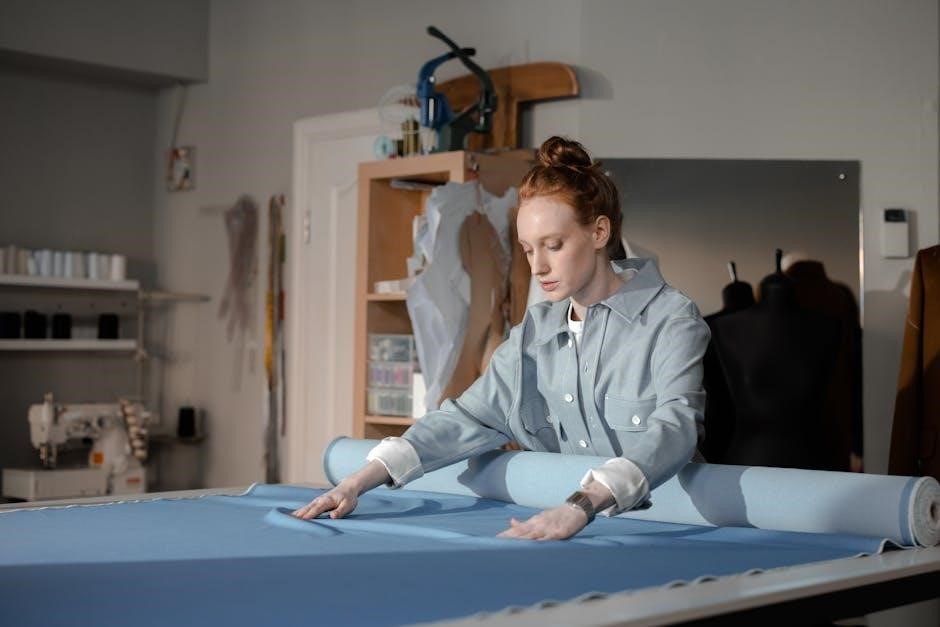
Adding Decorative Stitches or Embellishments
Elevate your sewing machine cover by incorporating decorative stitches or embellishments. Topstitching‚ embroidery‚ or appliqué can add a personal touch‚ making your cover unique. Use contrasting thread colors for visible stitching or opt for subtle tones for a refined look. Embellishments like buttons‚ ribbons‚ or fabric paint can also enhance the design. Consider adding decorative stitches along seams or edges for a polished finish. These details not only personalize your cover but also showcase your creativity. Experiment with different techniques to create a one-of-a-kind piece that reflects your sewing style and complements your workspace. This step allows you to infuse your personality into the project.
Tips and Tricks for a Perfect Fit
Ensure a perfect fit by accurately measuring your machine and using flexible foam stabilizers. Adjust patterns for different sizes and test with muslin before final sewing.
Troubleshooting Common Fitting Issues
When making a sewing machine cover‚ common fitting issues can arise‚ such as the cover being too tight or too loose; Start by double-checking your measurements to ensure accuracy. If the cover is too tight‚ consider adding a small seam allowance or using stretchier fabric. For a loose fit‚ adjust the pattern by reducing the width slightly. Fabric choice can also impact fit; opt for sturdy materials like cotton or denim for stability. Additionally‚ ensure proper alignment of seams and use binding correctly to avoid puckering. If the cover doesn’t sit evenly‚ trim excess fabric or reshape the pattern. Testing with muslin first can help identify and resolve fitting issues before cutting your final fabric.
Adjusting the Pattern for Different Machine Sizes
One of the great advantages of using a free sewing machine cover pattern PDF is the ease of adjusting it to fit various machine sizes. Start by measuring your sewing machine’s height‚ width‚ and depth to ensure a precise fit. For smaller machines‚ reduce the pattern dimensions slightly‚ while larger machines may require extending the sides or adding extra panels. If your machine has unique features‚ such as an extended arm or attachments‚ incorporate these into the design by modifying the pattern accordingly. Testing the fit with a muslin prototype before cutting your final fabric can help identify any necessary adjustments. This ensures a tailored‚ professional-looking cover that protects and complements your machine perfectly.
Creating a sewing machine cover using a free PDF pattern is a fun‚ practical project. Protect your machine and add style to your sewing space with ease.
Final Thoughts on Making a Sewing Machine Cover
Creating a sewing machine cover is a rewarding DIY project that combines functionality with creativity. Using a free PDF pattern‚ you can craft a cover that protects your machine from dust and adds a personal touch to your sewing space. The process is straightforward‚ requiring basic sewing skills and materials like fabric‚ binding‚ and stabilizers. Customization options‚ such as reversible designs or decorative stitches‚ allow you to tailor the cover to your style. Whether you’re a beginner or an experienced sewer‚ this project offers a sense of accomplishment and a practical way to care for your sewing machine. Give it a try and enjoy the satisfaction of handmade craftsmanship!
Encouragement to Try the Project
Creating a sewing machine cover is an excellent way to protect your machine while expressing your creativity. With free PDF patterns available‚ you can easily customize the design to match your sewing room decor. This project is perfect for sewists of all skill levels‚ offering a quick and satisfying outcome. Whether you’re looking to protect your machine from dust or add a decorative touch‚ this DIY project is both functional and fun. Grab some fabric‚ download a free pattern‚ and get sewing—you’ll love the sense of accomplishment and the personalized result!

